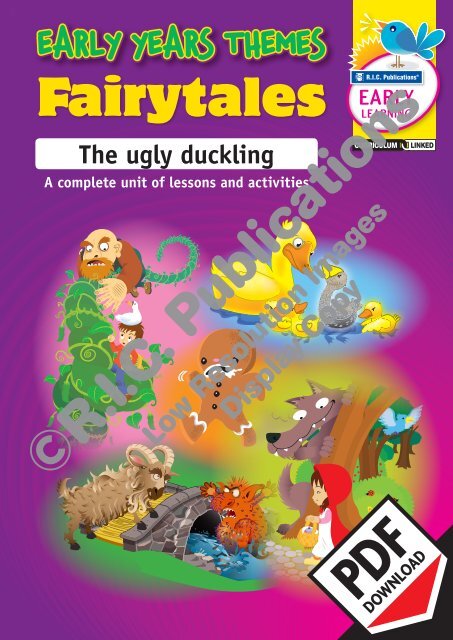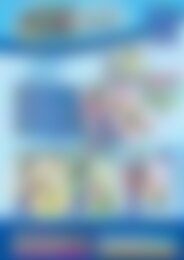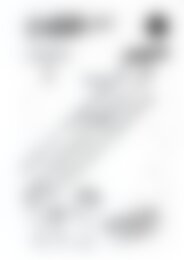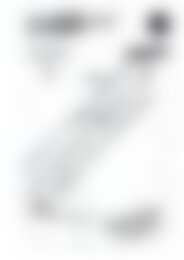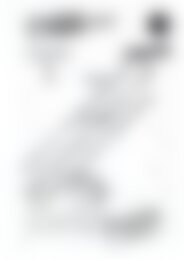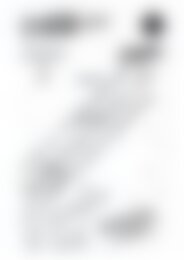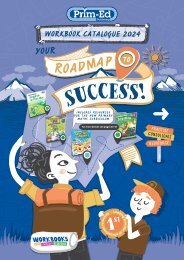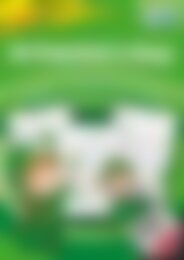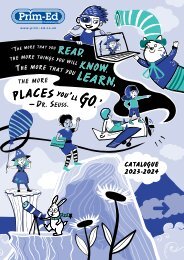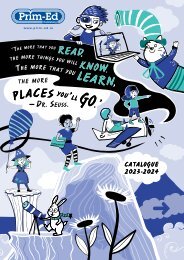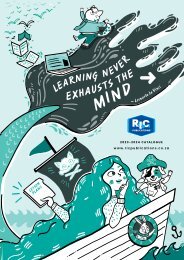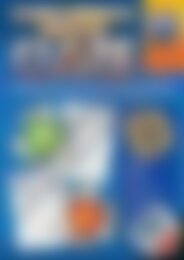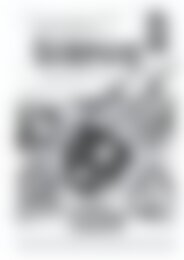RIC-20938 Early years Fairytales - Ugly Duckling
Create successful ePaper yourself
Turn your PDF publications into a flip-book with our unique Google optimized e-Paper software.
EARLY YEARS THEMES<br />
<strong>Fairytales</strong><br />
The ugly duckling<br />
A complete unit of lessons and activities
<strong>Early</strong> <strong>years</strong> themes—<strong>Fairytales</strong><br />
Published by R.I.C. Publications ® 2011<br />
Copyright © R.I.C. Publications ® 2011<br />
<strong>RIC</strong>– <strong>20938</strong><br />
Titles in this series:<br />
<strong>Early</strong> <strong>years</strong> themes—Places<br />
<strong>Early</strong> <strong>years</strong> themes—People<br />
<strong>Early</strong> <strong>years</strong> themes—Animals<br />
<strong>Early</strong> <strong>years</strong> themes—Science<br />
<strong>Early</strong> <strong>years</strong> themes—Fantasy<br />
<strong>Early</strong> <strong>years</strong> themes—<strong>Fairytales</strong><br />
<strong>Early</strong> <strong>years</strong> themes—Special days and celebrations<br />
Copyright Information<br />
Only the blackline masters contained within this<br />
publication may only be reproduced by the original<br />
purchaser for use with their class(es). The publisher<br />
prohibits the loaning or onselling of these blackline<br />
masters for purposes of reproduction. No other part<br />
of this publication may be reproduced in any form or<br />
by any means, electronic or mechanical, including<br />
photocopying or recording, or by any information<br />
storage and retrieval system, without written<br />
permission from the publisher.<br />
Accompanying resources available:<br />
<strong>Early</strong> <strong>years</strong> themes—<strong>Fairytales</strong> Posters (set of 5)<br />
<strong>Early</strong> <strong>years</strong> themes—<strong>Fairytales</strong> Stickers (set of 5)<br />
<strong>Early</strong> <strong>years</strong> themes Interactive CD (Places, People,<br />
Animals, Science)<br />
<strong>Early</strong> <strong>years</strong> themes Interactive CD (Fantasy, <strong>Fairytales</strong>,<br />
Special days and celebrations)<br />
Internet websites<br />
In some cases, websites or specific URLs may be recommended. While these are checked and rechecked at the time of publication,<br />
the publisher has no control over any subsequent changes which may be made to webpages. It is strongly recommended that the class<br />
teacher checks all URLs before allowing students to access them.<br />
View all pages online<br />
PO Box 332 Greenwood Western Australia 6924<br />
Website: www.ricpublications.com.au<br />
Email: mail@ricgroup.com.au
Teachers notes<br />
The format of this series of books<br />
This series of books is designed to cater for early childhood teachers who use learning centres and cross-curricular activities as<br />
a basis for planning activities to develop key concepts and skills. Teachers will easily be able to locate activity-based learning<br />
within this complete compilation of ideas.<br />
All of the five themes within each book follow the same format over 20 pages. Each theme consists of:<br />
1. A title or cover page with<br />
appropriate artwork which the<br />
teacher can utilise for themebased<br />
activities.<br />
2. A number of pages of cross-curricular learning activities to develop the<br />
theme. Those themes which relate closely to a specific learning area may<br />
have more activities in key learning areas such as science. All themes<br />
have activities which are predominantly ‘hands-on’.<br />
3. Background information with useful facts about the theme.<br />
4. A list of concepts to be developed provides suggested developmentallyappropriate<br />
learning outcomes to be achieved by completing the theme.<br />
iv <strong>Early</strong> <strong>years</strong> themes—<strong>Fairytales</strong> www.ricpublications.com.au – R.I.C. Publications ®
Teachers notes<br />
The format of this series of books<br />
5. A small number of resource/blackline pages which can be used<br />
to create games or oral language activities, as templates for art<br />
and craft activities or as worksheets for more capable children who<br />
are beginning to read and understand mathematical concepts.<br />
6. Recipes relating to the theme—<br />
simple cooking and non-cooking<br />
recipes, including those for<br />
manipulative play, such as ‘goop’.<br />
7. Display ideas for art and craft or<br />
specific learning centres.<br />
8. A list of literature resources to<br />
complement the theme, including<br />
songs, action rhymes and fiction<br />
and nonfiction books.<br />
9. A notes section to enable the teacher<br />
to record useful websites or resources<br />
relating to the theme, or other<br />
worthwhile activities or ideas etc.<br />
R.I.C. Publications ® – www.ricpublications.com.au <strong>Early</strong> <strong>years</strong> themes—<strong>Fairytales</strong> v
Teachers notes<br />
An explanation of the icons<br />
A number of icons have been used throughout the cross-curricular activities sections to make it easier and quicker for teachers to<br />
locate appropriate learning activities.<br />
Fine motor activities—building with blocks, puzzles, sorting, sand and water play, sensory items<br />
such as ‘feely boxes’, playdough or clay work, threading, chalkboards, construction using recycled<br />
materials such as boxes<br />
Outdoor play—sand and/or water play (see also ‘fine motor activities’); gross motor activities such as<br />
climbing, balancing, bikes, scooters, jumping, throwing, obstacle course activities etc.; tracking activities<br />
using balloons and bubbles etc.; other messy art activities<br />
Dramatic play—home corner, dramatising stories, dressing up, puppets, shopping etc.<br />
Art and craft—free painting, directed and supervised painting,<br />
craft (assisted and independent)<br />
Computer—suggestions for simple games or activities<br />
(usually individual or pairs) or relevant internet activities<br />
Cooking—supervised activities, some of which use heat<br />
Games—indoor or outdoor games relating to literacy such as card<br />
games, memory games etc.; mathematics, singing games, any<br />
physical education games involving movement etc.<br />
Writing—tracing, copying, writing on, and with, different things—cards, different types of paper etc.;<br />
adding patterns or stripes etc.; tracking and following paths, dot-to-dot activities etc.<br />
vi <strong>Early</strong> <strong>years</strong> themes—<strong>Fairytales</strong> www.ricpublications.com.au – R.I.C. Publications ®
Teachers notes<br />
About the artwork<br />
All the artwork in this series of books is:<br />
• age-appropriate<br />
• teacher- and child-friendly<br />
• an additional resource to help develop the theme<br />
• suitable for enlarging for:<br />
~ colouring<br />
~ handwriting<br />
~ dot-to-dot sheets<br />
~ use as templates for art and craft activities<br />
~ visual texts to encourage oral language development.<br />
Some artworks are based on simple shapes to support learning in the mathematics<br />
area; others are more elaborate. It is anticipated that early childhood teachers will<br />
view an illustration based on shapes and be able to use this idea to develop concrete<br />
play activities using shapes or as a technology and design project. More elaborate<br />
artwork is used to demonstrate a teaching resource which needs to be made, a recipe,<br />
game or other activity.<br />
Examples of artwork relating to art and craft activities have wide, bold, easily visible<br />
cutting outlines to allow the children some variation in the cutting path they will use.<br />
About the resource sheets/blacklines<br />
Resource sheets/blacklines contain:<br />
• simple, age-appropriate artwork<br />
• prominent visual clues<br />
• little or no text<br />
• visual clues to support text pages<br />
• few instructions, so as not to confuse beginning readers<br />
• teacher instructions in the margins with a number of different<br />
suggestions for using the resource sheet/blackline<br />
• literacy and numeracy activities.<br />
These resource sheets/blacklines are included as valuable time-savers<br />
for teachers.<br />
It is anticipated that the teacher will enlarge any pages to A3 size and<br />
photocopy them onto more durable paper or card, to make them easier<br />
for learners of this age group to manipulate.<br />
The cross-curricular section of each theme includes a reference to<br />
resource sheets/blacklines relating to specific activities.<br />
R.I.C. Publications ® – www.ricpublications.com.au <strong>Early</strong> <strong>years</strong> themes—<strong>Fairytales</strong> vii
Teachers notes<br />
Curriculum links<br />
All the learning activities in this series of books support the key learning areas of the current curriculum documents.<br />
In particular, one or more activities also support each strand of the new English and Mathematics National Curriculum. The<br />
specific strands from the National Curriculum relating to each activity are denoted by the words in brackets in the English and<br />
Mathematics learning areas of the cross-curricular section.<br />
For example, in the ‘The three billy goats Gruff’ theme:<br />
English Talk about the use of capital letters for the beginning of special names such as ‘Gruff’. Create a goat from<br />
a large capital ‘G’. Use cardboard, paper, crayons and googly eyes. Alternatively, cover a lower-case ‘g’<br />
with Easter grass. (Language)<br />
Mathematics<br />
Reference to both is shown below.<br />
Provide coloured pattern blocks or coloured paper shapes for the children to create goat shapes from.<br />
(Measurement and Geometry)<br />
Relevant curriculum reference<br />
NSW<br />
Qld<br />
SA<br />
Vic.<br />
WA<br />
National Curriculum: refer to pages 6 and 11 of Shape of the Australian Curriculum: English<br />
National Curriculum: refer to pages 6 and 7 of Shape of the Australian Curriculum: Mathematics<br />
National Curriculum: Science learning activities also support pages 6 and 7 of Shape of the Australian<br />
Curriculum: Science<br />
Belonging, being and becoming: The early <strong>years</strong> framework for Australia (2009)<br />
Refer to <strong>Early</strong> <strong>years</strong> curriculum guidelines page 55 (Table 9: A<br />
summary of the learning statements in the early learning areas)<br />
and pages 61–75.<br />
Refer to ‘<strong>Early</strong> <strong>years</strong> band: Age 3–Age 5’. South Australian<br />
Curriculum, Standards and Accountability at .<br />
Refer to Victorian essential learning standards Level 1 at<br />
.<br />
Refer to K-3 scope-and-sequence charts at .<br />
viii <strong>Early</strong> <strong>years</strong> themes—<strong>Fairytales</strong> www.ricpublications.com.au – R.I.C. Publications ®
Teachers notes<br />
Sample social skills checklist<br />
Date:<br />
Student name<br />
separates easily from<br />
parents<br />
interacts readily with<br />
adults<br />
interacts readily with<br />
peers<br />
shares with others and<br />
takes turns<br />
participates in group<br />
activities<br />
cooperates with others<br />
accepts responsibility<br />
for own behaviour<br />
respects the property<br />
of others<br />
respects the feelings of<br />
others<br />
listens without<br />
interrupting<br />
expresses feelings<br />
appropriately<br />
solves simple problems<br />
is developing an<br />
awareness of the wider<br />
community<br />
R.I.C. Publications ® – www.ricpublications.com.au <strong>Early</strong> <strong>years</strong> themes—<strong>Fairytales</strong> ix
Teachers notes<br />
Sample language skills checklist<br />
Date:<br />
Student name<br />
communicates needs clearly<br />
articulates most words correctly<br />
relates personal experiences<br />
contributes to discussions<br />
uses age-appropriate<br />
vocabulary<br />
articulates most initial sounds<br />
correctly<br />
asks appropriate questions<br />
speaks in complete sentences<br />
relates events in order of<br />
occurrence<br />
able to tell a story from pictures<br />
retells a familiar story without<br />
pictures or clues<br />
uses simple compound<br />
sentences<br />
responds appropriately to<br />
questions about himself/herself<br />
listens to a story for a given<br />
length of time<br />
follows simple two-step<br />
instructions<br />
knows his/her first and last<br />
names<br />
recognises rhyming words<br />
answers simple oral cloze<br />
questions<br />
labels emotions such as happy,<br />
sad, angry, scared …<br />
x <strong>Early</strong> <strong>years</strong> themes—<strong>Fairytales</strong> www.ricpublications.com.au – R.I.C. Publications ®
Teachers notes<br />
Sample fine motor skills checklist<br />
Date:<br />
Student name<br />
completes simple puzzles<br />
builds a tower of eight or more<br />
small blocks<br />
dresses himself/herself (apart<br />
from buttons and shoelaces)<br />
manipulates playdough to<br />
create a specific object<br />
places small pegs in small<br />
holes<br />
threads small beads<br />
uses scissors to cut out simple<br />
shapes and pictures<br />
completes simple folding<br />
activities<br />
uses a knife, fork and spoon<br />
correctly<br />
holds a crayon or pencil<br />
correctly<br />
colours within lines<br />
writes or copies own name<br />
draws and copies simple<br />
pictures<br />
copies a sequence of letters or<br />
numbers adequately<br />
traces or recreates patterns<br />
R.I.C. Publications ® – www.ricpublications.com.au <strong>Early</strong> <strong>years</strong> themes—<strong>Fairytales</strong> xi
Teachers notes<br />
Sample fundamental movement skills checklist<br />
Date:<br />
Explicit teaching<br />
Exposure<br />
Student name<br />
balances on one<br />
foot (static balance)<br />
runs<br />
jumps vertically<br />
catches a ball or<br />
beanbag<br />
hops<br />
throws a ball or<br />
beanbag using an<br />
overarm movement<br />
gallops sideways<br />
skips<br />
leaps<br />
kicks a ball<br />
strikes a ball or<br />
object using a twohanded<br />
strike<br />
dodges a ball or<br />
object<br />
xii <strong>Early</strong> <strong>years</strong> themes—<strong>Fairytales</strong> www.ricpublications.com.au – R.I.C. Publications ®
Teachers notes<br />
Sample mathematics skills checklist<br />
Date:<br />
Number and algebra Measurement and geometry Statistics and probability<br />
Student name<br />
recognises numerals 1 to<br />
writes numerals 1 to<br />
rote counts to<br />
places numerals to<br />
in correct order<br />
understands one-to-one<br />
correspondence<br />
understands ‘more than’ and ‘less<br />
than’<br />
able to do simple addition and<br />
subtraction using concrete materials<br />
shares collections<br />
creates or completes a pattern<br />
measures using everyday items<br />
makes comparison of size and<br />
length<br />
recognises basic shapes<br />
identifies attributes of objects and<br />
collections<br />
is aware of use of devices used<br />
for measuring (scales, tape etc.)<br />
shows awareness of<br />
(money, temperature, time)<br />
sorts or orders objects<br />
is aware of collections and<br />
presentations of data<br />
interprets data in a display<br />
makes predictions about chance<br />
events<br />
R.I.C. Publications ® – www.ricpublications.com.au <strong>Early</strong> <strong>years</strong> themes—<strong>Fairytales</strong> xiii
xiv <strong>Early</strong> <strong>years</strong> themes—<strong>Fairytales</strong> www.ricpublications.com.au – R.I.C. Publications ®
Cross-curricular activities<br />
• Read two or more different versions of ‘The ugly<br />
duckling’ to the children and compare them. Discuss<br />
each cover illustration, author’s name (if applicable),<br />
illustrator’s name, illustrations, text and back cover.<br />
Talk about the differences and similarities in authors,<br />
events, characters, text and illustrations. Ask them to<br />
say which version they prefer. Count the votes if desired.<br />
(Language, Literature)<br />
• Encourage the children to bring any versions of the<br />
fairytale which they may have at home to display or<br />
talk about. (Language, Literature)<br />
• Read a variety of other fairytales to the children so that<br />
they are familiar with the beginning and ending phrases<br />
(For example: ‘Once upon a time …’ and ‘… they lived<br />
happily ever after’.) Explain that fairytales usually<br />
include these phrases. (Language, Literacy)<br />
• Revise or introduce the initial sounds of ‘u’ for ‘ugly’ and ‘d’<br />
for ‘duckling’. List as a class, or encourage the children as<br />
individuals to write or draw pictures of other words which<br />
begin with ‘u’ or ‘d’ on an umbrella or duckling shape.<br />
(Language)<br />
• As a class, make up sensible or nonsense phrases and<br />
sentences using words starting with ‘u’ and ‘d’, for example:<br />
‘ugly umbrella’ and ‘dirty dumplings’. Clap the syllables in<br />
the phrases. Provide paper and drawing implements to<br />
allow the children to draw funny pictures describing the<br />
phrases and sentences. Urge the children to make up<br />
some of their own to illustrate, if desired. Encourage them<br />
to try to write their own words. (Language)<br />
• Introduce or revise the ‘s’ sound for ‘swan’. Brainstorm to<br />
list, write and draw pictures of things which begin with ‘s’.<br />
(Language, Literacy)<br />
• Talk about words relating to the story which are<br />
opposites: ugly/beautiful, fat/thin, rich/poor, fast/<br />
slow, wet/dry, young/old, good/bad, happy/sad, safe/<br />
dangerous etc. Dramatise any which are applicable,<br />
such as fast/slow.(Language)<br />
• Play the game ‘I am thinking of a word which rhymes<br />
with “swan”’. Provide a clue to help the children guess.<br />
Use words such as on, gone, John, bonbon and<br />
Taiwan. (Language)<br />
English<br />
• Brainstorm to list words which rhyme with ‘ugly’ and<br />
‘duckling’. (Language)<br />
• Introduce, or revise, the term ‘characters’. Select specific<br />
characters in the story to discuss. Ask: ‘What are they<br />
like?’, ‘What did they do?’. Be sure to select characters<br />
relevant to the particular version of the fairytale being<br />
used. Complete a similar activity about ‘settings’.<br />
Provide paper and implements for the children to draw<br />
pictures of the farm, the marshes, the cottage and the<br />
garden. (Literature)<br />
• Clap the syllables in specific words relating to the story;<br />
for example: duckling, ugly, swan. (Language)<br />
• Make up a class fairytale. Sit in a circle. The teacher<br />
starts the fairytale with ‘Once upon a time …’ and<br />
then each child is given an opportunity to add a line<br />
to the story. For those children who are reticent or<br />
need inspiration, provide pictures of various fairytalelike<br />
characters (witch, fairy, dwarf, giant, troll etc.),<br />
places (castle, forest, lake etc.) and related items (a<br />
magic wand, a bottle labelled poison etc.). This allows<br />
these children to select a picture of something they<br />
would like to add to the class fairytale. When the story<br />
is completed, ask each child to illustrate his/her own<br />
part of the story. To make remembering each part of<br />
the fairytale easier, tape the activity on a recorder or<br />
camera. (Language, Literature, Literacy)<br />
• Place A4- or A3-sized outlines of the lower-case letter<br />
‘u’ at the writing table for the children to add features to<br />
make it ‘ugly’. Discuss what types of things the children<br />
think would make a person (or animal) look ‘ugly’ and<br />
why. Provide a variety of coloured drawing utensils (as<br />
suggested by the children) and collage materials to<br />
complete an ugly ‘u’. (Language, Literacy)<br />
• Provide cardboard copies of<br />
the letter ‘s’ for the children to<br />
add white paper shapes and/or<br />
feathers onto to create a swan.<br />
(Language, Literacy)<br />
• Practise wavy writing patterns<br />
by using large implements such<br />
as crayons and blue paint and<br />
paintbrushes. Use the patterns<br />
to create a pond for a duck<br />
or swan. Refer to page 70.<br />
(Language, Literacy)<br />
62 <strong>Early</strong> <strong>years</strong> themes—<strong>Fairytales</strong>—The ugly duckling www.ricpublications.com.au – R.I.C. Publications ®
The ugly duckling – 1<br />
Mathematics<br />
• Look at, and compare, the sizes of various eggs:<br />
duck, swan, turkey, emu, chicken, ostrich etc. Order<br />
from largest to smallest, or smallest to largest. Use<br />
templates of different sizes to trace around and cut out<br />
the different-sized eggs. In order of size, from largest<br />
to smallest, the eggs are: ostrich, emu, turkey, swan,<br />
duck and chicken. Refer to page 71. (Measurement<br />
and Geometry)<br />
Ostrich egg Swan egg Turkey egg Duck egg Lark egg<br />
• Play the game ‘Place the eggs in the nest’. Provide<br />
children with coloured, laminated, cardboard nest<br />
shapes, and up to 10 smaller egg shapes. When<br />
asked, the children place a given number of eggs in<br />
the nest. Alternatively, nest shapes can be created for<br />
a specific number of egg outlines for the children to<br />
complete. (Number and Algebra)<br />
• Place a variety of different sized, coloured and dressed<br />
rubber ducks in the water tray. Ask the children to sort<br />
them into groups and give reasons for placing the<br />
ducks in the categories. (Number and Algebra)<br />
• At the bottom of recycled egg cartons, write the numbers<br />
1 to 12 (or use half of a carton and write the numbers 1<br />
to 6) using black marker. Give each child an egg carton<br />
and ask them to place the correct number of counters in<br />
each space as directed. (Number and Algebra)<br />
• Talk about mathematical words which are opposites<br />
such as big/little, tall/short, fat/thin, full/empty, long/<br />
short, near/far, high/low. Relate these to various<br />
aspects of the story; for example: the duckling was little<br />
but the mother duck was big; spring was warm but<br />
winter was cold. (Measurement and Geometry)<br />
• Use coloured wooden blocks to create a duck or swan<br />
shape. A pattern block template can be provided or the<br />
children could be encouraged to create their own. Once<br />
the shape duck or swan is completed, count how many<br />
shapes were used in total, as well as the number of<br />
each type used. Encourage the children to make more<br />
than one duck or swan shape and to use different<br />
shapes. Refer to page 69 for a duck template to use.<br />
(Measurement and Geometry, Number and Algebra)<br />
• Sequence pictures of the main events of ‘The ugly duckling’<br />
in the correct order. Refer to page 75. (Measurement and<br />
Geometry)<br />
• Play a ‘How many legs?’ counting game with the<br />
children. Ask: ‘In the nest, there was one egg. How<br />
many legs were there after the duckling hatched?’<br />
Repeat the game using a different number of eggs in<br />
the nest and hatched ducklings. (Number and Algebra)<br />
• Make simple word patterns using the words ‘duck’ and<br />
‘swan’—e.g. ‘duck, duck, swan, duck, duck, swan’.<br />
Use the children (wearing simple masks or headbands<br />
with duck or swan shapes on them) to stand in line to<br />
create the patterns. (Statistics and Probability)<br />
• Discuss the possibility of a mother duck confusing<br />
a duck’s egg with a swan’s egg. (Statistics and<br />
probability; Understanding)<br />
• Discuss how the swan’s egg came to be in the duck’s<br />
nest: Who could have put it there? Why? How possible<br />
is it that each reason given may have occurred?<br />
(Statistics and probability)<br />
• On a basic duckling shape, ask the children to cut (or<br />
tear), and glue on small pieces of grey or dull-coloured<br />
tissue paper squares or circles to cover the whole area.<br />
Overlap them to create a textured ‘feathery’ effect. When<br />
dry, cut off any paper protruding over the outline. Add<br />
googly eyes and a coloured paper triangular beak.<br />
(Measurement and Geometry)<br />
R.I.C. Publications ® – www.ricpublications.com.au <strong>Early</strong> <strong>years</strong> themes—<strong>Fairytales</strong>—The ugly duckling 63
Cross-curricular activities<br />
Society and environment<br />
• Swans build a nest in which to lay their eggs. Look at<br />
images of swans’ nests and use large wooden blocks to<br />
construct similar nests. Talk about other animal homes<br />
and their names—burrow, den, lair, hutch, pond, hive,<br />
cocoon, kennel, stable etc.<br />
• Ask the children to relate personal experiences relating<br />
to swans or ducks. Ask the children where they went to<br />
see the swans and/or ducks, what the event was and<br />
what happened. Encourage them to describe the birds’<br />
feet, feathers, colour, shape and size. The children may<br />
wish to draw or write about the experience for a class<br />
book.<br />
• The ugly duckling’s was the last, and largest, egg to<br />
hatch. This means he was the youngest in the family.<br />
Ask the children about their position in the family. Are<br />
they the oldest/youngest/only/middle? Encourage the<br />
children to find out how much they weighed at birth<br />
and, if possible, bring in a baby photo of themselves<br />
and their favourite baby toy. They may also be able to<br />
find out the exact time they ‘hatched’.<br />
• Swans eat mostly underwater vegetation (such as<br />
roots, tubers, stems and leaves), but in winter they<br />
also eat grass or grains. Occasionally, they may also<br />
eat insects and some aquatic animals. Talk about how<br />
swans get the underwater food. Some wildlife parks<br />
provide specially prepared bags of grain for visitors<br />
to buy to feed to ducks or swans. If possible, let the<br />
children examine some.<br />
• Sequence pictures in the correct order to show the<br />
progression from egg to adult swan. Refer to page 72.<br />
Health and physical education<br />
• Hold an egg-and-spoon race using plastic or hard-boiled<br />
eggs. Have the children walk, run or waddle to a designated<br />
spot while balancing the egg on the spoon.<br />
• Teach the children this skipping rope rhyme (starting<br />
with ‘d’) which they can use to play games within the<br />
playground: ‘Dum-dum-dodo’. Catch me if you can, I can<br />
jump better than can’. Select a child to jump while<br />
the verse is being recited. Then the named person enters<br />
the rope and selects someone else.<br />
• Play the game ‘Duck, duck, goose’ but change the words to<br />
‘Duck, duck, swan’. Refer to for instructions to<br />
how to play.<br />
• Create an obstacle course representing the major events in<br />
the story in order: Provide hoops for the children to ‘waddle’<br />
around in like ducks in a nest; lay out a large plastic<br />
tarpaulin to swim across on stomachs; set up witch’s hats<br />
(marshy area) to run through; cover adult-sized chairs<br />
with a blanket as the cottage to creep through; provide a<br />
balance beam to walk across (or balance flat on the back)<br />
to represent the frozen lake; provide a triangular climbing<br />
frame to traverse (for the farmer’s hut); provide a balancing<br />
board representing the cold, hard winter; and, finally, set<br />
up swings to ‘fly high’ like a swan.<br />
• Provide your children with eggs cooked in different<br />
ways (hard-boiled, scrambled, poached, fried etc.)<br />
and let them taste the difference and state their<br />
preference.<br />
• Find images of cygnets (baby swans) and ducklings<br />
from internet or book resources and ask: ‘Are the<br />
cygnets ugly?’ Hopefully, the answer will be ‘No’.<br />
The children should then look at the ducklings and<br />
answer a similar question: ‘Are the ducklings ugly?’<br />
Ask the children why the other animals might have<br />
teased and bullied him. Lead them to the notion<br />
that he was ‘different’. Discuss how wrong it is to<br />
tease and bully others just because they may look<br />
different.<br />
• After reading the story, talk about its main message:<br />
that everyone is special. Talk about how mean the<br />
other ducklings were, then discuss some of the<br />
nice things they could have said instead. Discuss<br />
how important words are. Create and write down or<br />
memorise some nice things the children can say to<br />
each other.<br />
64 <strong>Early</strong> <strong>years</strong> themes—<strong>Fairytales</strong>—The ugly duckling www.ricpublications.com.au – R.I.C. Publications ®
The ugly duckling – 2<br />
Drama<br />
• Ask the children to make ‘ugly’ faces while looking at a<br />
small mirror. Provide sheets of art paper and drawing<br />
implements, including large black crayons. Fold the<br />
paper in half (landscape position) and ask the children<br />
to sketch their ‘ugly’ face on one side and their normal<br />
‘beautiful’ face on the other. Encourage the children to<br />
draw large enough to fill each half and to include all<br />
details, lines and shapes that they see. Ask the children<br />
to write or copy a label for each side. (NOTE: Be sensitive<br />
to children with low self-esteem.)<br />
• Bring a pair of children’s swimming flippers or thick<br />
rubber gloves for the children to wear while pretending<br />
to walk like ducks and swans.<br />
• Provide a wide brown, grey or white scarf, gathered in<br />
the middle, for the children to use as a pair of wings<br />
while pretending to be the ugly duckling or swan. Ask<br />
the children to hold the ends and move their arms like<br />
flapping wings. Have two pairs to use in a waddling or<br />
flying race over a distance.<br />
My beautiful face<br />
My ugly face<br />
• Use a hot-glue gun (or strong glue) to edge plastic<br />
children’s sunglasses with white, grey or brown feathers<br />
for use as masks in the dramatic play area. Alternatively,<br />
use a cardboard template for the children to make their<br />
own. Refer to page 74.<br />
• Create simple stick or felt finger puppets for use with<br />
a class-made puppet theatre. (Cut apart a recycled<br />
packing box so that it has a front and two sides to<br />
support it. Cut out a window from the front section and<br />
tape this to the bottom to help support the theatre. Paint<br />
and decorate with sequins, glitter and stickers. Attach a<br />
piece of material on dowelling for a moveable curtain.)<br />
Music<br />
• Select children to dramatise or role-play events or<br />
scenes from the story.<br />
• Purchase inexpensive feather boas for the children to<br />
wrap around themselves to experience being covered<br />
in feathers. If desired, attach them securely to an old<br />
T-shirt so that the children appear to have feathers<br />
covering their entire body.<br />
• Ask the parents to donate old clothes or costumes<br />
to enable the children to dress up as their favourite<br />
character from a fairytale.<br />
• Select and play various types of<br />
music (slow, fast, sad and happy)<br />
for the children to glide, swim<br />
quickly, run, waddle, fly, be sad and<br />
happy to.<br />
• Reinforce levels of movement by<br />
asking the children to waddle low to<br />
the ground (like a duck or swan) and<br />
stretch up high with arms spread to<br />
fly through the air.<br />
• Listen to various farm animal sounds such as ducks quacking. Visit<br />
to listen to sounds relating to swans. (Some make very<br />
little sound at all!)<br />
• Learn simple fingerplays about ducks such as ‘Five little ducks went out<br />
one day …’ and ‘Six little ducks that I once knew …’.<br />
• Listen to excerpts from Swan Lake and ask the children to move to the<br />
music.<br />
• Listen to ‘The last grey swan’ at .<br />
• Visit to<br />
listen to excerpts from ‘The little swan’ by Ven Olac.<br />
• Various singing versions relating to ‘The ugly duckling’, such that sung<br />
by Danny Kaye, and ‘The ugly duckling blues’ by Susan Harrison, are<br />
available from internet sources.<br />
R.I.C. Publications ® – www.ricpublications.com.au <strong>Early</strong> <strong>years</strong> themes—<strong>Fairytales</strong>—The ugly duckling 65
Cross-curricular activities<br />
Science<br />
• What other creatures hatch from eggs? Make a list and<br />
find pictures of them. Include pictures of birds, reptiles<br />
such as snakes and crocodiles, chickens, fish and<br />
dinosaurs.<br />
• Talk about, and list, names (such as ‘duckling’ and<br />
‘cygnet’) for other baby animals. If possible, find<br />
pictures and label each with the correct baby animal<br />
name for a chart to display in the writing corner.<br />
• Where do I live? Ducks and swans live near small<br />
bodies of water such as ponds, lakes and wetlands.<br />
Ask the children where specific animals may live; e.g.<br />
‘I am a pig. I live in a s .’ Include both domestic<br />
and wild animals. Extend the activity by asking the<br />
children to use large wooden construction blocks to<br />
build different animal habitats.<br />
• Discuss the seasons, winter and spring, mentioned<br />
in the story. Fold sheets of paper into halves for each<br />
child to draw a winter picture on one side and a spring<br />
picture on the other. Attach a baby cygnet (or ugly<br />
duckling), cut from coloured paper, to the winter side<br />
and a white swan to the spring side. If desired, paint the<br />
two different sides of a paper plate to represent winter<br />
and spring.<br />
• Ducks and swans have feathers which cover their body.<br />
What do other animals have as coverings? Find books<br />
with pictures of animals with fur, scales, skin, shells,<br />
hair, spines, armour etc. Cut and glue pictures on card<br />
to create collages labelled ‘These animals all have<br />
feathers/fur/shells/scales … ’ etc.<br />
• Carry out reflection experiments. The ugly duckling was<br />
very surprised when he saw his reflection in the water,<br />
and he had changed into a swan. Ask the children to<br />
study their reflection in the water tray or a large plastic<br />
container of water. Test to see if the reflection is clearer<br />
in the sun or shade. Pull faces to make sad, happy,<br />
ugly and other faces. Make ripples in the water with<br />
fingers or pencils to see how the reflection changes.<br />
Carry out similar activities using mirrors but distort the<br />
images using plastic cling wrap, greaseproof or baking<br />
paper, or lines drawn across the mirror using fingers<br />
dipped in Vaseline .<br />
• Look at pictures of different<br />
kinds of eggs and compare<br />
them in relation to size and<br />
colour. Try to match each to<br />
the correct animal.<br />
• If possible, obtain some duck<br />
feathers and demonstrate,<br />
by pouring water over them,<br />
how ducks stay dry.<br />
Technology and design<br />
• Hold ‘rubber ducky’ races. Use energy provided by<br />
blowing to propel two rubber ducks across the water<br />
tray. The child whose duck reaches the other side first<br />
is the winner.<br />
• Talk about different ways ducks and swans move—<br />
swim, glide, fly. Dramatise each type of movement.<br />
• Complete various online duck jigsaw<br />
puzzles at .<br />
• Colour a picture of the ugly duckling<br />
at .<br />
• View, and/or listen to, a version of ‘The ugly duckling’ on the internet.<br />
• Provide a variety of white materials such as serviettes, pipe-cleaners,<br />
polystyrene shapes, paper, tissues, feathers, felt etc. for the children to<br />
plan a design for, and create, a swan.<br />
• Experiment with a variety of utensils and paint to find an appropriate<br />
method to print feathers on the body of a duck or swan. Use in conjunction<br />
with the window scene mentioned in the ‘Visual arts’ section.<br />
• Refer to the ‘Music’ section for various internet sites relating to singing,<br />
dancing and listening.<br />
66 <strong>Early</strong> <strong>years</strong> themes—<strong>Fairytales</strong>—The ugly duckling www.ricpublications.com.au – R.I.C. Publications ®
The ugly duckling – 3<br />
Visual arts<br />
• Use grey or brown paint handprints to create an ugly<br />
duckling (with the thumb forming<br />
the neck and the spread fingers<br />
forming the body and feathers).<br />
Print a head shape by using a<br />
round cork or similar circular<br />
shape. When dry, use coloured<br />
markers to draw the beak, eye and<br />
wing details.<br />
• Use a similar technique and white paint to<br />
make a handprint of a swan. Use extra-white paint and<br />
a brush to extend the neck into a curve and head. Add a<br />
beak and eyes using coloured markers when dry.<br />
• Use this activity to demonstrate how something that<br />
appears ugly can actually be beautiful. Ask the children<br />
to use wax crayons to completely colour sections of<br />
a sheet of art paper or card. Ensure that they press<br />
heavily and leave no white gaps. When completed, ask<br />
them to apply a thick layer of black paint over the top.<br />
Allow to dry. Give each child a craft stick to scratch out<br />
a drawing or pattern. The resulting artwork will be bright<br />
and highlighted by the black sections. Discuss how the<br />
artwork shows that we cannot always judge others by<br />
what they look like.<br />
• Provide inexpensive yellow rubber ducks (one for each<br />
child) and thick paint. Paint the yellow rubber ducks<br />
grey or brown to create an ‘ugly duckling’ and add<br />
features such as feathers to make them cygnets.<br />
• Have each child trace around their foot on grey or brown<br />
coloured paper and cut it out. Glue small triangular<br />
pieces torn from tissue paper to the body for feathers.<br />
Trace around five or six hand shapes in similar or<br />
contrasting colours and cut out. Glue to the back in<br />
a fan shape for duck feathers. Attach googly eyes, a<br />
triangular beak and feet.<br />
• Look at pictures of duck’s nests. Discuss the<br />
shape, materials used and how the eggs<br />
are positioned. Use natural materials such<br />
as grass, twigs, sticks, mud and feathers to<br />
make a duck’s nest in a grassy area near the<br />
classroom. Fill with playdough or clay eggs.<br />
• Use a template to show a duckling emerging from an<br />
egg. Refer to page 73.<br />
• Use a template to cut out two flying swan shapes<br />
from white felt. Refer to for ideas. Ask the<br />
children to sew around the edges. Leave a gap to stuff<br />
the toy with wadding or scrap material. Stuff, then sew<br />
up the gap. Glue on a button eye and draw wings by<br />
using a black marker. Hang the toy by using wool to<br />
make a display of swans flying across the room.<br />
• Practise folding skills to create a simple swan shape<br />
from a single sheet of white A4 paper. Fold a large<br />
square in half from one end to form a triangular body.<br />
Cut off excess paper. Fold a small square in half to form<br />
a triangular head. Fold the remaining rectangle in half<br />
to form a long neck. Glue or staple the edges of each<br />
piece and then glue or staple all three pieces together.<br />
Add features as desired.<br />
fold<br />
fold<br />
cut<br />
cut<br />
• Provide soft brown clay for the children to make 3-D<br />
models of the ugly duckling and white clay to mould a<br />
swan. Display on a mirror to simulate water. If desired,<br />
the children could create rushes and grass from green<br />
playdough to stand around the edges.<br />
• Add ‘snow’ and ‘ice’ by using packing beads or torn or<br />
crumpled white crepe paper, to a painted winter scene<br />
from the story.<br />
• Create simple stick or finger puppets to dramatise the<br />
story of ‘The ugly duckling’. Ask the children to draw or<br />
paint the characters onto cardboard, then cut them out.<br />
Add a craft stick handle and a label.<br />
• Using blue and green paint one crumpled paper, paint<br />
a window pane to make it look like a pond. (Add a<br />
small amount of dishwashing liquid to the paint to<br />
make removing easier.) Paint or attach duck and swan<br />
outlines to complete the scene.<br />
R.I.C. Publications ® – www.ricpublications.com.au <strong>Early</strong> <strong>years</strong> themes—<strong>Fairytales</strong>—The ugly duckling 67
Teacher background information<br />
A fairytale is a story, usually written for children, that most often deals with fantastic characters such as princesses, princes,<br />
fairies, goblins, elves, trolls, giants, witches, and other mythical creatures. Often a quest is involved and the tales usually have<br />
a happy ending. <strong>Fairytales</strong> were originally used to teach morals or values. Some of the most popular fairytales are ‘Cinderella’,<br />
‘Sleeping Beauty’, ‘Hansel and Gretel’, ‘Rapunzel’ and ‘Little Red Riding Hood’.<br />
‘The ugly duckling’ was written by Hans Christian Anderson in 1843. It differs from many fairytales in that it does not have<br />
fantastical characters. There are several different versions available, all based on Anderson’s original. Teachers should select and<br />
read to the children the version that they prefer before commencing this theme. A synopsis of the original fairytale is written below.<br />
Mother Duck sat on her nest, waiting for her eggs to hatch. Soon the eggs cracked, and pretty,<br />
yellow, fluffy ducklings hatched. However, the last, and largest, egg did not hatch with the rest. Finally,<br />
the last baby hatched, but it was large and grey. ‘It must be a baby turkey’, Mother Duck thought. ‘I’ll<br />
take all of my babies to the pond to swim. If the large one can not swim, I’ll know that it is a turkey.’<br />
In the water, all the ducklings, including the ugly duckling, swam happily. ‘The ugly duckling must be<br />
one of my babies after all’, she thought.<br />
Mother Duck took her babies to the other farm animals to show them off. The other ducks thought<br />
there were already too many ducks at the farm. Also, they thought that the ugly duckling was very<br />
ugly. One duck flew at the ugly duckling and bit him on the neck. From that time, the ugly duckling<br />
was bitten, pushed, laughed at and made fun of by the other ducks and poultry. Even worse, the<br />
farm girl kicked him and his brothers, sisters and mother were unkind to him.<br />
Finally, he ran away to a large pond where wild ducks lived. He stayed there until hunters came.<br />
They killed many of the ducks and frightened others away. The ugly duckling hid in the reeds. Even<br />
the hunting dogs thought he was so ugly that they left him alone.<br />
The ugly duckling ran away from the pond to a little cottage. He crept inside through a small<br />
opening at the bottom of the door. In the cottage lived a tomcat, a woman and a hen. The woman<br />
let him stay, hoping he would lay eggs. After a few weeks, the ugly duckling had not laid any eggs.<br />
Also, the cat and hen did not become his friends. The ugly duckling left the cottage.<br />
He hid in some water nearby and did not go near the other animals. Autumn arrived and the<br />
weather became cold. One night, as the sun went down, a flock of beautiful birds came out of<br />
the reeds. The birds were swans. They had long, graceful necks and soft, white feathers. The ugly<br />
duckling thought he had never seen anything so beautiful. They spread their wings and flew away.<br />
The ugly duckling wanted to be as lovely as the swans.<br />
The weather grew colder. The water froze and the ugly duckling lay helpless on a small patch of<br />
ice. The next morning, a farmer found him and took him home to his wife. In the warm cottage, the<br />
duckling began to feel better. When the children tried to play with him, he flapped his wings in fright.<br />
He knocked over the milk pan and spilt milk all over the floor. The woman clapped her hands. He<br />
flew into the butter barrel and the grain tub. The woman yelled at him, and hit him with the tongs. The<br />
children laughed and tried to catch him. The ugly duckling flew out the door and hid among the<br />
bushes. He lay there in the falling snow. Cold and hungry, he stayed there all through the winter.<br />
Gradually, the weather became warmer and spring arrived. The ugly duckling flapped his strong<br />
wings and flew into a large garden filled with flowering trees. From the bushes nearby, three beautiful<br />
swans appeared and entered the water. They looked so lovely gliding across the water that the<br />
ugly duckling decided to join them. He did not care if they hurt him or not. He swam towards them,<br />
not caring what they said or did. Then a wonderful thing happened! As he looked into the water,<br />
he saw his own reflection. No longer was he a grey, ugly duckling. He was a beautiful young swan!<br />
He no longer cared that he had been sad or teased by other animals. He was finally happy. The<br />
other swans swam to him and stroked his neck. When the children came to the pond, they saw the<br />
beautiful new young swan. They threw him bread and cake crumbs. The children said he was the<br />
most beautiful swan of them all.’<br />
• That everyone is special and unique.<br />
• No-one is the same as any other person.<br />
• No-one should be mean to anyone else.<br />
• Everyone should be accepted as they are.<br />
Concepts to be developed<br />
68 <strong>Early</strong> <strong>years</strong> themes—<strong>Fairytales</strong>—The ugly duckling www.ricpublications.com.au – R.I.C. Publications ®
Instructions: Count the number of shapes used altogether and the number of each type used. Colour each type of shape with a different colour. This template could be used as motivation for the children to<br />
make pattern block shape pictures of their own.<br />
Shape duckling<br />
There are<br />
shapes altogether.<br />
How many of each shape?<br />
R.I.C. Publications ® – www.ricpublications.com.au <strong>Early</strong> <strong>years</strong> themes—<strong>Fairytales</strong>—The ugly duckling 69
Follow the numbers on the path<br />
9.<br />
7.<br />
10.<br />
3.<br />
1.<br />
8.<br />
4.<br />
2.<br />
6.<br />
5.<br />
Instructions: Enlarge to A3 size if desired. The children start at 1 and follow the numbers through the pathway to complete the swan picture. Trace the dotted lines to draw the reeds and water.<br />
70 <strong>Early</strong> <strong>years</strong> themes—<strong>Fairytales</strong>—The ugly duckling www.ricpublications.com.au – R.I.C. Publications ®
Order the eggs by size<br />
lark’s<br />
egg<br />
Instructions: Enlarge to A3 size. Cut out the eggs and glue them in order from largest to smallest, or smallest to largest. Add patterns to decorate them.<br />
chicken’s<br />
egg<br />
duck’s<br />
egg<br />
turkey’s<br />
egg<br />
swan’s<br />
egg<br />
R.I.C. Publications ® – www.ricpublications.com.au <strong>Early</strong> <strong>years</strong> themes—<strong>Fairytales</strong>—The ugly duckling 71
Picture sequencing<br />
Instructions: Use the pictures for discussion OR reproduce onto card, colour, cut out and laminate for sequencing. Multiple copies could be reproduced for use as a card game such as ‘Memory’ or ‘Concentration’.<br />
72 <strong>Early</strong> <strong>years</strong> themes—<strong>Fairytales</strong>—The ugly duckling www.ricpublications.com.au – R.I.C. Publications ®
Hatching egg<br />
Instructions: Enlarge to A3 size. Colour the pieces, then cut them out. Join all three pieces together by using a split paper fastener. Place the duckling at the back and the two halves of the eggshell at the<br />
front. Open to reveal the duckling hatching from the egg.<br />
The ugly<br />
duckling<br />
R.I.C. Publications ® – www.ricpublications.com.au <strong>Early</strong> <strong>years</strong> themes—<strong>Fairytales</strong>—The ugly duckling 73
<strong>Ugly</strong> duckling and swan masks<br />
74 <strong>Early</strong> <strong>years</strong> themes—<strong>Fairytales</strong>—The ugly duckling www.ricpublications.com.au – R.I.C. Publications ®<br />
Instructions: Photocopy the masks onto card of an appropriate colour, or onto white card for painting. Colour, paint or decorate using appropriate materials. The designs could be used as inspiration for the children<br />
to create their own masks by using collage materials. Blank masks are readily available from craft stores. Two masks of the same shape could be created and glued back to back so that one side shows the ugly<br />
duckling and the other the swan.
Instructions: Enlarge and photocopy onto card. Colour, cut out and laminate. Look at and discuss the scenes from the story. Ask the children to sequence the scenes in the correct order. Write sentences to<br />
accompany each scene and display on a board. NOTE: The scenes are from the version of the story written on page 68.<br />
Story sequencing<br />
R.I.C. Publications ® – www.ricpublications.com.au <strong>Early</strong> <strong>years</strong> themes—<strong>Fairytales</strong>—The ugly duckling 75<br />
Ha!<br />
Ha!<br />
Ha!<br />
Ha!<br />
Ha!<br />
Ha!<br />
Ha!
Recipes<br />
Eggs in a nest – 1 (Sweet)<br />
Ingredients<br />
• 225 g milk chocolate for cooking<br />
• 1 packet Cornflakes or Shredded Wheat cereal<br />
• chocolate or candy mini eggs<br />
• paper cupcake liners<br />
Instructions<br />
• Break the milk chocolate into pieces and melt in a microwave oven or a bowl over simmering water. When completely<br />
melted, remove from heat and stir well. Add enough cereal to make a brown ‘twiggy’ look. Spoon into paper cupcake liners<br />
and (once cool enough) use thumb to make a well in the centre. Place two or more mini eggs in the centre and press down<br />
gently. Leave to set.<br />
Eggs in a nest – 2 (Savoury)<br />
Ingredients<br />
• long wholemeal pasta (such as spaghetti or fettuccine)<br />
• chopped bacon strips<br />
• hard-boiled eggs<br />
• fresh parsley sprigs<br />
Instructions<br />
• Boil pasta until al dente. Meanwhile, gently fry bacon strips until browned. Place a quantity of pasta on each child’s plate. Ask<br />
them to use a plastic fork to arrange the pasta into a nest shape. Top with some bacon strips, parsley sprigs and two or three<br />
hard-boiled egg slices.<br />
Meringue swans<br />
Ingredients<br />
• white meringue nests (available from supermarkets) for the swan’s body<br />
• white marshmallows (available from supermarkets) for the swan’s head<br />
• white icing (for attaching head and features)<br />
• soft orange sweets or sections of red glacé cherries (for beak)<br />
• chocolate chips for eyes<br />
• whipped cream (optional)<br />
• banana slices (optional)<br />
Instructions<br />
• Use icing to attach head, beak and eyes to the body. Fill back of swan with whipped cream and banana slices, if desired.<br />
Duck salad<br />
Ingredients<br />
• lettuce leaves<br />
• pear halves (fresh or canned)<br />
• cheese slices<br />
• sultanas<br />
Instructions<br />
• Arrange a lettuce leaf on a paper plate. Place pear half flat side down/rounded side up<br />
on top of the lettuce. Cut three triangular pieces from the cheese. Place one at the head<br />
for a beak and two at the bottom for feet. Place two<br />
sultanas at the top for eyes. (If necessary,<br />
secure using toothpick halves, peanut<br />
butter [staying aware of children’s<br />
allergies] or cream cheese.)<br />
76 <strong>Early</strong> <strong>years</strong> themes—<strong>Fairytales</strong>—The ugly duckling www.ricpublications.com.au – R.I.C. Publications ®
Recipes<br />
Duck sandwich<br />
Ingredients<br />
• brown, wholemeal or pumpernickel bread slices<br />
• cream cheese<br />
• cold meat slices (such as roast beef)<br />
• cheese<br />
• green peas (for eyes)<br />
• capsicum pieces/slivered almonds/parsley<br />
Instructions<br />
• Use a large round biscuit cutter to make circles from slices of bread. Each child will need two slices for the body. Spread<br />
the slices with cream cheese. Place a slice of cold meat on one slice and top with another circle of bread. Insert capsicum,<br />
almonds or parsley between the slices for feathers. Use a small round biscuit cutter to make a head from another slice of<br />
bread. Spread one side with cream cheese and place (spread side down) on larger slices. Use extra cream cheese to add<br />
features—green pea eyes and a small triangle of cheese for the beak.<br />
Another suggestion:<br />
• Use white bread and chicken slices to create a swan in a similar fashion.<br />
Ingredients<br />
• small resealable bag (one for each child)<br />
• bowls containing a variety of finger foods<br />
(popped corn, sultanas or raisins, chopped<br />
dried apricots, chocolate chips etc.)<br />
Swan sculpture<br />
Duck food<br />
Ingredients<br />
• red or green apples cut into semicircular slices<br />
• cream cheese/peanut butter*<br />
• small, round paper plate covered with a blue serviette<br />
Instructions<br />
• Ask the children to arrange the apple slices on the ‘water’ to form a swan<br />
shape, joining the pieces together with cream cheese or peanut butter.<br />
Note: Be aware of any children who may have allergies to peanuts.<br />
Instructions<br />
• Give each child a resealable bag. Ask them to add some of each type of<br />
preferred food from the bowls to the bag and seal. Children enjoy it as<br />
a snack to feed the ‘ducks’ (themselves). Note: Ensure that children do<br />
not use the food to feed actual ducks as ingredients may be harmful.<br />
Duck/Swan biscuits<br />
Ingredients<br />
• 200 g self-raising flour<br />
• 100 g caster sugar<br />
• 100 g butter or margarine<br />
• 1 egg, beaten<br />
• grated rind and juice of half a lemon<br />
• sultanas (for eyes)<br />
Instructions<br />
• Mix together flour and sugar. Mix in butter or margarine with fingertips. Add<br />
lemon rind and juice, and enough beaten egg to make a stiff dough. Roll out<br />
thinly, and cut into duck or swan shapes using a biscuit cutter. Add a sultana<br />
eye to each. (If desired, this step can be omitted, with separate eyes added<br />
using chocolate chips or Smarties and icing or extra melted chocolate when<br />
cool.) Place on a greased baking tray. Bake for 15 minutes at 180 °C, then<br />
remove to cool.<br />
R.I.C. Publications ® – www.ricpublications.com.au <strong>Early</strong> <strong>years</strong> themes—<strong>Fairytales</strong>—The ugly duckling 77
Display ideas<br />
Scene(s) from the story<br />
• Cover a bulletin board with lengths of blue material or paper. Staple or pin a darker shade to the bottom as the water and a<br />
lighter shade across the top as the sky. Roll and tape tubes of brown paper for reeds and attach in groups to the sides, top<br />
and at intervals around the water. Ask the children to make individual ugly ducklings and swans from paper plates and attach<br />
to the display. (Some ideas for paper plate ducks and swans are shown.)<br />
Stained glass drawing<br />
• Look at and discuss pictures of mother swans and cygnets.<br />
Ask the children to draw a picture of a mother swan and<br />
cygnet on black paper by using white glue. Allow to dry<br />
overnight. Use coloured chalks or chalk pastels to fill the<br />
sections between the glue lines. Spray with hairspray or<br />
artist’s fixative to prevent smudging.<br />
Pond window display<br />
• Using crumpled paper and paint, decorate a large window<br />
pane to create a pond scene. Draw water plants, and<br />
duck and swan outlines to complete the scene. (Add a<br />
small amount of dish washing liquid to the paint to make<br />
removal easier.) If a number of smaller windows are<br />
available for use, paint scenes from the story in sequence.<br />
Ask the children to suggest the main scenes to be drawn.<br />
Duck/Swan printing<br />
• Use a duck- and swan-shaped biscuit cutter to cut duck<br />
and swam ‘stamps’ from thick slices of raw potato. Use<br />
with white and yellow paint to print patterns on dark or<br />
contrasting coloured paper. If desired, print an all-over<br />
pattern of swans and a single duck or vice versa for greater<br />
impact.<br />
Life cycle of a duck or swan<br />
• Have the children construct an egg, a duckling or cygnet<br />
and an adult duck or swan by using cardboard or paper or<br />
by moulding with different coloured playdough. Place each<br />
in the correct position on a large paper plate or circular<br />
sheet of cardboard and draw an arrow between each. The<br />
children may wish to write or glue labels (egg, duckling/<br />
cygnet, duck/swan). If desired, the children can construct<br />
individual paper craft units of each part of the life cycle<br />
(egg, duckling/cygnet, duck/swan) for display on a large<br />
bulletin board and arranged in a circular format with larger<br />
labels and arrows.<br />
Beginning and ending<br />
• Have the children paint one scene from the beginning of<br />
the book (Mother Duck with the ugly duckling and other<br />
ducklings) and one scene from the end of the story (the<br />
young swan with the adult swans). Join together or display<br />
side by side. Label the first with the words ‘Once upon a<br />
time …’ and the second with ‘And they lived happily ever<br />
after’.<br />
78 <strong>Early</strong> <strong>years</strong> themes—<strong>Fairytales</strong>—The ugly duckling www.ricpublications.com.au – R.I.C. Publications ®
Literature resources – 1<br />
Stories<br />
• The ugly duckling (Flip-up fairytales) by Masumi Furukawa<br />
• Fairytale news by Colin and Jackie Hawkins<br />
• The ugly pumpkin by Dave Horowitz<br />
• The ugly vegetables by Grace Lin<br />
• Sleeping ugly by Jane Yolen<br />
• <strong>Ugly</strong> colours (<strong>Ugly</strong>dolls) by David Horvath<br />
• Lifecycle of a swan by Monica Hughes<br />
• <strong>Duckling</strong> (Watch me grow) by DK Publishing<br />
• The tale of Sir Dragon: Dealing with bullies for kids (and dragons) by Jean E Pendziwol<br />
• Tyrone, the horrible by Hans Wilhelm (A dinosaur book about bullying)<br />
Songs, action rhymes, fingerplays and poems<br />
Six little ducks<br />
Six little ducks that I once knew:<br />
Fat ones, skinny ones,<br />
Fair ones, too.<br />
But the one little duck<br />
With the feather on his back,<br />
He led the others<br />
With a quack, quack, quack!<br />
Quack, quack, quack,<br />
Quack, quack, quack!<br />
He led the others<br />
With a quack, quack, quack!<br />
Down to the river<br />
They would go:<br />
Wibble-wobble, wibble-wobble,<br />
To and fro.<br />
But the one little duck<br />
With the feather on his back,<br />
He led the others<br />
With a quack, quack, quack!<br />
Quack, quack, quack,<br />
Quack, quack, quack!<br />
He led the others<br />
With a quack, quack, quack!<br />
Back from the river<br />
They would come:<br />
Wibble-wobble, wibble-wobble,<br />
Ho-hum, hum.<br />
But the one little duck<br />
With the feather on his back,<br />
He led the others<br />
With a quack, quack, quack!<br />
Quack, quack, quack,<br />
Quack, quack, quack!<br />
He led the others<br />
With a quack, quack, quack!<br />
Into the water they would dive,<br />
Over and under the other five.<br />
But the one little duck<br />
With the feather on his back,<br />
He led the others<br />
With a quack, quack, quack!<br />
Quack, quack, quack,<br />
Quack, quack, quack!<br />
He led the others<br />
With a quack, quack, quack!<br />
Home from the river they would come:<br />
Wibble-wobble, wibble-wobble,<br />
Ho-hum hum.<br />
But the one little duck<br />
With the feather on his back,<br />
He led the others<br />
With a quack, quack, quack!<br />
Quack, quack, quack,<br />
Quack, quack, quack!<br />
He led the others<br />
With a quack, quack, quack!<br />
R.I.C. Publications ® – www.ricpublications.com.au <strong>Early</strong> <strong>years</strong> themes—<strong>Fairytales</strong>—The ugly duckling 79
Literature resources – 2<br />
Songs, action rhymes, fingerplays and poems<br />
Five little ducks<br />
Five little ducks (Hold up five fingers.)<br />
Went out one day,<br />
Over the hill and far away. (Move hand over shoulder.)<br />
Mother Duck said,<br />
‘Quack, quack, quack, quack!’ (Make a quacking motion with<br />
fingers of other hand.)<br />
But only four little ducks came back. (Show four fingers.)<br />
Four little ducks<br />
Went out one day,<br />
Over the hill and far away.<br />
Mother Duck said,<br />
‘Quack, quack, quack, quack!’<br />
But only three little ducks came back.<br />
Three little ducks<br />
Went out one day<br />
Over the hill and far away.<br />
Mother Duck said,<br />
‘Quack, quack, quack, quack!’<br />
But only two little ducks came back.<br />
<strong>Duckling</strong> hokey pokey<br />
(Tune: ‘Hokey pokey’)<br />
You put your right wing in, you take your right wing out,<br />
You put your right wing in and you shake it all about.<br />
You do the ‘<strong>Duckling</strong> pokey’ and you flap your wings and shout,<br />
‘That’s what it’s all about’.<br />
(Continue with left wing, right leg, left leg, head and whole self.)<br />
Swan swam over the sea (tongue twister)<br />
Swan swam over the sea:<br />
Swim, swan, swim!<br />
Swan swam back again:<br />
Well swum, swan!<br />
Notes<br />
Two little ducks<br />
Went out one day,<br />
Over the hill and far away.<br />
Mother Duck said,<br />
‘Quack, quack, quack, quack!’<br />
But only one little duck came back.<br />
One little duck<br />
Went out one day,<br />
Over the hill and far away.<br />
Mother Duck said,<br />
‘Quack, quack, quack, quack!’<br />
But none of the five little ducks came back.<br />
Sad Mother Duck<br />
Went out one day,<br />
Over the hill and far away.<br />
Sad Mother Duck said,<br />
‘Quack, quack, quack!’<br />
And all of the five little ducks came back.<br />
(Match fingers held up to the number of ducks<br />
in each verse.)<br />
80 <strong>Early</strong> <strong>years</strong> themes—<strong>Fairytales</strong>—The ugly duckling www.ricpublications.com.au – R.I.C. Publications ®


